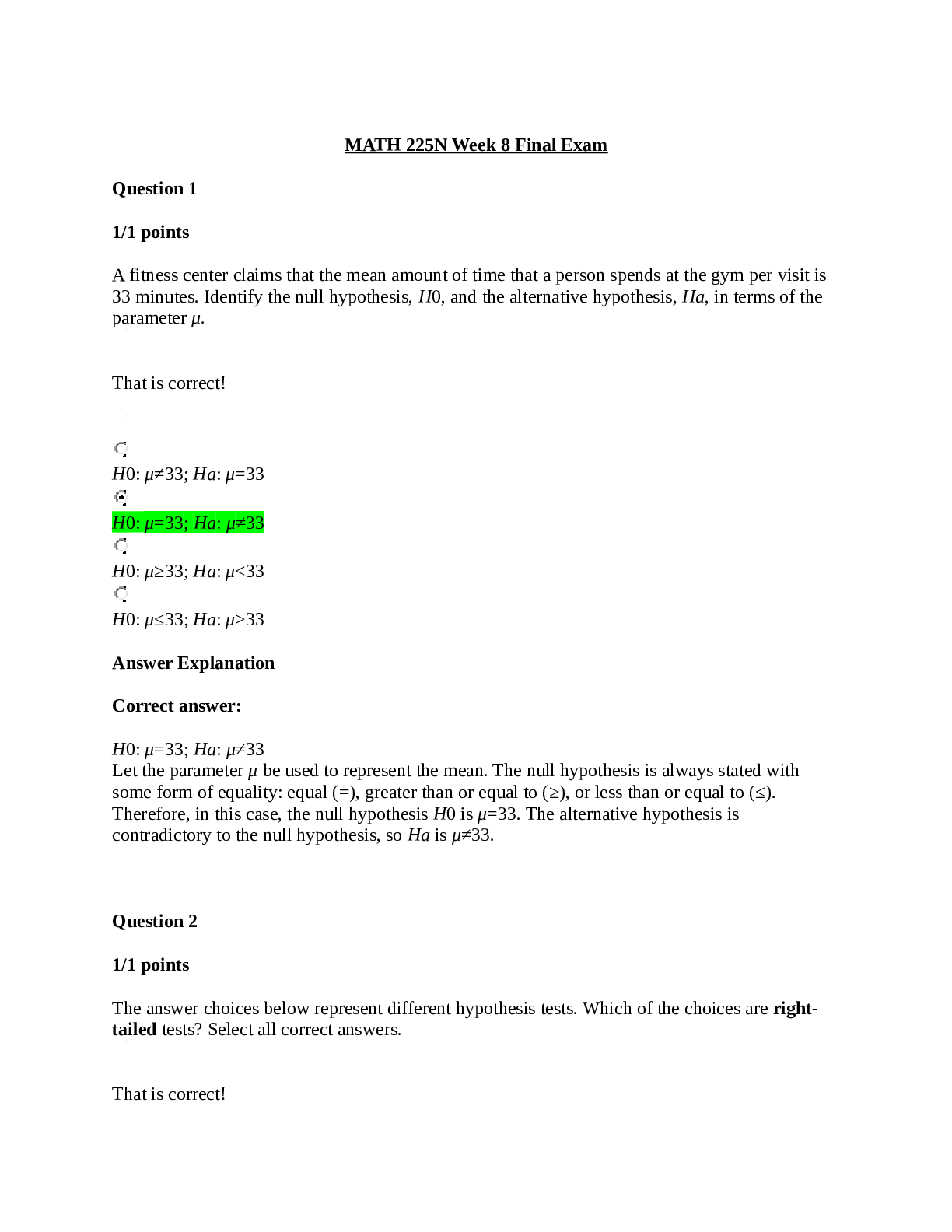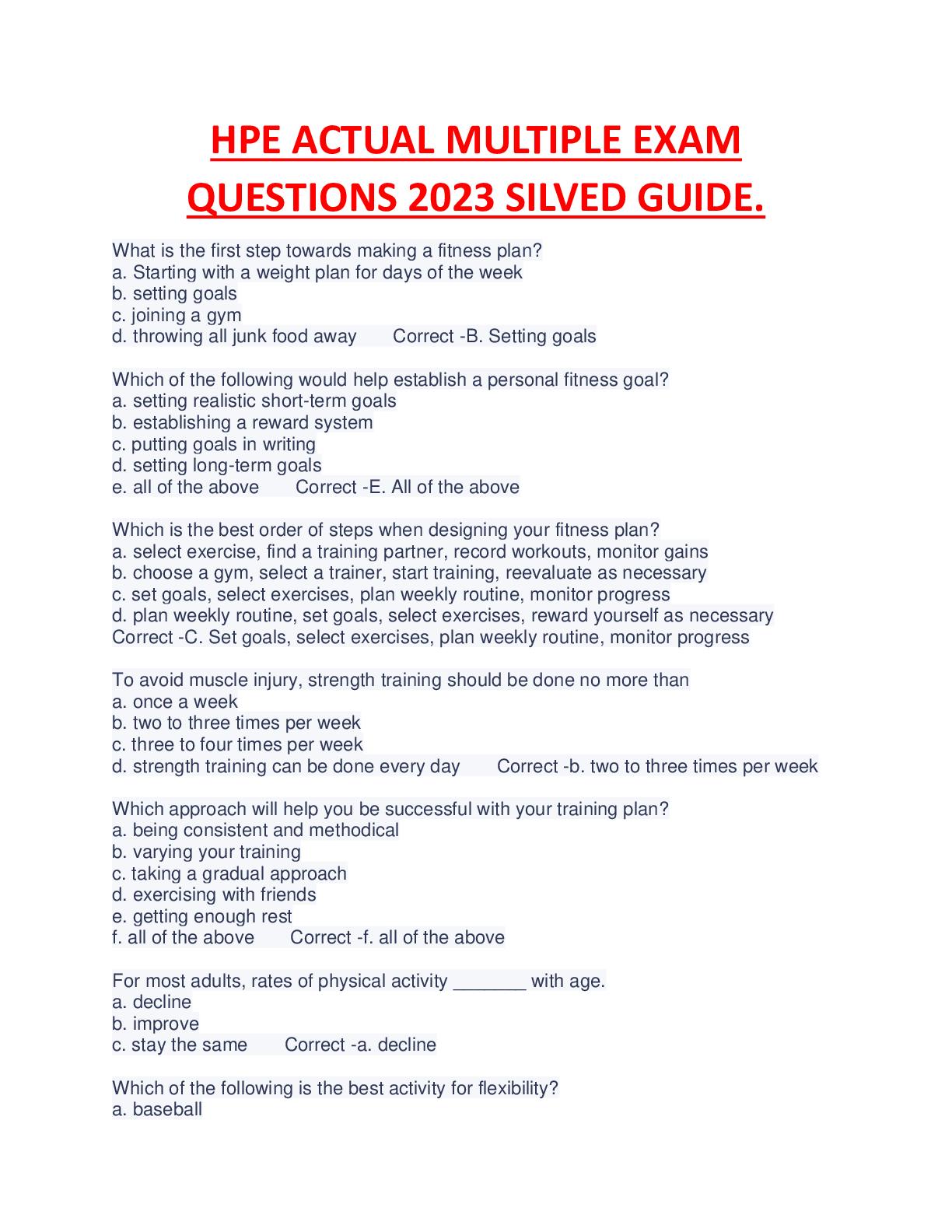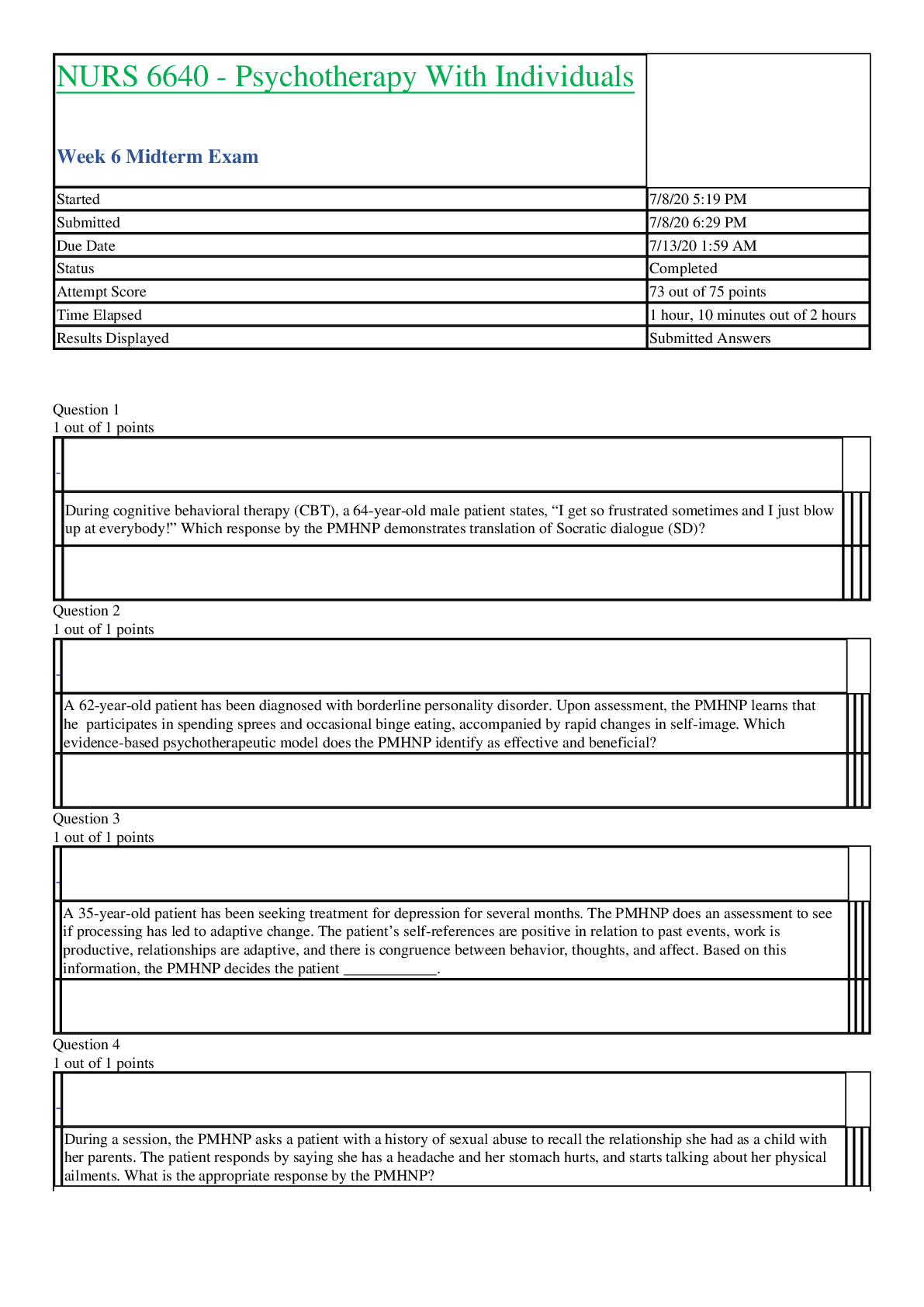*NURSING > EXAM > Hesi Saunders Online Review for the NCLEX-RN Examination 2 year 3rd Edition Module 4 Exam (graded (All)
Hesi Saunders Online Review for the NCLEX-RN Examination 2 year 3rd Edition Module 4 Exam (graded A ) 2022
Document Content and Description Below
A client with schizophrenia and his parents are meeting with the nurse. One of the young man’s parents says to the nurse, “We were stunned when we learned that our son had schizophrenia. He was no... different than from his older brother when they were growing up. Now he’s had another relapse, and we can’t understand why he stopped his medication.” Which response by the nurse is appropriate? ▪ Telling the parents, “Medication noncompliance is the most frequent reason that people with this diagnosis relapse.” ▪ Telling the parents, “Well, it’s his decision to take his medicine, but it’s yours to have him live with you if he stops the medication.” ▪ Asking the client, “How can we help you to take your medicine or to tell us when you’re having problems so that your medication can be adjusted?” Correct ▪ Saying to the parents, “Your concerns are appropriate, but I wonder whether your son was having trouble telling someone that he had concerns about his medication.” Rationale: The therapeutic response is the one in which the nurse models speaking directly to the client. This facilitates further assessment of the situation and helps elicit the causes of and motivations for the client’s behavior for both the nurse and the family. In the correct option, the nurse also seeks clarification of the degree of openness and mutuality felt by the client and his family toward each other. The nurse provides information to the family when stating that noncompliance is the most frequent reason for relapse in people with this diagnosis. However, the statement is nontherapeutic at this time because it does not facilitate the expression of feelings. The nurse uses a superego style of communication when stating, “Well, it’s his decision to take his medicine, but it’s yours to have him live with you if he stops the medication.” The content of this statement may be true, but it is nontherapeutic in that it carries a threatening message and may prevent the family from trusting the nurse. By stating, “Your concerns are appropriate, but I wonder whether your son was having trouble telling someone that he had concerns about his medication,” the nurse gives approval and prematurely analyzes the client’s motivation without sufficient assessment. Test-Taking Strategy: Use your knowledge of therapeutic communication techniques and remember to focus on the client’s feelings. Also note that the correct option is the only option in which the nurse directly addresses the client. Review: therapeutic communication techniques . Reference: Stuart, G. (2009). Principles & practice of psychiatric nursing (9th ed., pp. 27-31). St. Louis: Mosby. Varcarolis, E., & Halter, M. (2009). Essentials of psychiatric mental health nursing: A communication approach to evidence-based care (p. 297). St. Louis: 2. 2.ID: 21083973127 A client with schizophrenia says, “I’m away for the day ... but don’t think we should play or do we have feet of clay?” Which alteration in the client’s speech does the nurse document? ▪ Neologism ▪ Word salad ▪ Clang association Correct ▪ Associative looseness Rationale: Clang association is the meaningless rhyming of words in which the rhyming is more important than the context of the words. A neologism is a made- up word that has meaning only to the client. Word salad is the term for a mixture of meaningless phrases, either to the client or to the listener. Associative looseness is a term used to describe schizophrenic speech in which connections and threads are interrupted or missing. Test-Taking Strategy: Knowledge of the speech patterns exhibited by the client with schizophrenia is needed to answer this question. Focus on the subject in the question, the meaningless rhyming of words. Review: these speech patterns . Reference: Varcarolis, E., & Halter, M. (2009). Essentials of psychiatric mental health nursing: A communication approach to evidence-based care (p. 281). St. Louis: Saunders. Level of Cognitive Ability: Applying Client Needs: Psychosocial Integrity Integrated Process: Communication and Documentation Content Area: Mental Health Giddens Concepts: Communication, Psychosis HESI Concepts: Cognition Awarded 100.0 points out of 100.0 possible points. Saunders. Level of Cognitive Ability: Applying Client Needs: Psychosocial Integrity Integrated Process: Communication and Documentation Content Area: Mental Health Giddens Concepts: Adherence, Psychosis HESI Concepts: Adherence, Cognition Awarded 100.0 points out of 100.0 possible points. 3. 3.ID: 21083973124 An acutely ill client with schizophrenia says to the nurse, “He keeps saying that he likes you, and I keep telling him you’re married, but he won’t listen, and I think he’s going to get fresh with you.” Once the nurse has determined that the client is hallucinating, which response to the client would be most appropriate statement? ▪ “Try not to listen to the voices right now so that I can talk with you.” Correct ▪ “I think that you can help him stop his behavior if you concentrate.” ▪ “Tell him I said to mind his p’s and q’s or I’ll call the police on him.” ▪ “I think that you’re trying to share your own feelings toward me, but you’re shy.” Rationale: The appropriate statement by the nurse is the one that does not acknowledge the client’s hallucinations. By responding, “I think that you can help him stop his behavior if you concentrate” or “Tell him I said to mind his p’s and q’s or I’ll call the police on him,” the nurse acknowledges the hallucinations. The nurse attempts to interpret the client’s thinking with a statement such as “I think that you’re trying to share your own feelings toward me, but you’re shy.” Test-Taking Strategy: Note the strategic words “most appropriate.” Use your knowledge of therapeutic communication techniques and remember that the nurse should not acknowledge the client’s hallucinations. Also note that the correct option is the only one that encourages realistic verbalization from the client. Review: therapeutic communication techniques with a client who is hallucinating . References: Stuart, G. (2009). Principles & practice of psychiatric nursing (9th ed., pp. 27-31). St. Louis: Mosby. Varcarolis, E., & Halter, M. (2009). Essentials of psychiatric mental health nursing: A communication approach to evidence-based care (pp. 287, 288). St. Louis: Saunders. Level of Cognitive Ability: Applying Client Needs: Psychosocial Integrity Integrated Process: Communication and Documentation Content Area: Mental Health Giddens Concepts: Communication, Psychosis HESI Concepts: Cognition, Communication Awarded 100.0 points out of 100.0 possible points. 4. 4.ID: 21083973121 A client says to the nurse, “It’s over for me — the whole thing is over.” Which response by the nurse would be therapeutic? ▪ “What do you mean, ‘The whole thing is over’?” ▪ “Over? Well, that sounds pretty drastic to me. Let’s discuss this in the strictest confidence.” ▪ “Can you tell me more about why it’s over for you? I’ll keep your thoughts strictly confidential.” ▪ “Let’s talk more about your feeling that the whole thing is over for you. This is important, and I may need to share your feelings with other staff members.” Correct Rationale: The therapeutic response seeks clarification, employs paraphrasing, and informs the client that the nurse needs to share any information that requires crisis intervention with other staff members. Asking, “What do you mean, ‘The whole thing is over’?” employs paraphrasing, but the message is blunt and closed- ended. In stating, “Over? Well, that sounds pretty drastic to me. Let’s discuss this in the strictest confidence,” the nurse uses hysterical exaggeration (at an inappropriate time) and gives incorrect information regarding confidentiality. In stating, “Can you tell me more about why it’s over for you? I’ll keep your thoughts strictly confidential,” the nurse uses the therapeutic technique of seeking clarification but does not clarify with the client that the information might need to be shared. Test-Taking Strategy: Eliminate the comparable or alike options that indicate that shared information will be maintained as confidential. To select from the remaining options, focus on the statement that addresses the client’s feelings. Review: therapeutic communication techniques . Reference: Stuart, G. (2009). Principles & practice of psychiatric nursing (9th ed., pp. 27-31). St. Louis: Mosby. Level of Cognitive Ability: Applying Client Needs: Safe and Effective Care Environment Integrated Process: Communication and Documentation Content Area: Mental Health Giddens Concepts: Communication, Psychosis HESI Concepts: Cognition, Communication Awarded 100.0 points out of 100.0 possible points. 5. 5.ID: 21083973118 The nurse performing a lethality assessment asks the client whether he is thinking of suicide. Which statement by the client would be of most concern to the nurse? ▪ “No, I wasn’t, but I am now, thanks to you.” Correct ▪ “I hadn’t thought of that, but I can see that you are.” ▪ “Of course not, but there are days when I think that I should be.” ▪ “What is suicide going to do for me except get me excommunicated from the church?” Rationale: The client’s response that he is now thinking about suicide is of the greatest concern to the nurse. In making the statement “I hadn’t thought of that, but I can see that you are” the client projects his own thoughts of suicide onto the nurse. In stating, “Of course not, but there are days when I think that I should be,” the client is being sarcastic but is not specifically talking about suicide. In stating, “What is suicide going to do for me except get me excommunicated from the church?” the client indicates that suicide is not an option because of his religious beliefs. Test-Taking Strategy: Note the strategic word “most.” Note the words “but I am now” in the correct option. This is the only option that identifies definite suicidal thoughts. Review: lethality assessment in the suicidal client . References: Stuart, G. (2009). Principles & practice of psychiatric nursing (9th ed., pp. 27-31). St. Louis: Mosby. Varcarolis, E., & Halter, M. (2009). Essentials of psychiatric mental health nursing: A communication approach to evidence-based care (p. 412). St. Louis: Saunders. Level of Cognitive Ability: Analyzing Client Needs: Safe and Effective Care Environment Integrated Process: Nursing Process/Assessment Content Area: Mental Health Giddens Concepts: Mood and Affect, Safety HESI Concepts: Mood & Affect, Safety Awarded 100.0 points out of 100.0 possible points. 6. 6.ID: 21083973115 A client who has expressed suicidal ideation in the past says to the nurse, while shuffling several documents in an effort to organize them, “Well, I’m feeling so much better now since I got organized. My lawyer wrote my will and durable power of attorney.” Which response by the nurse is most appropriate? ▪ “Good grief! You don’t look organized to me.” ▪ “Okay, what are you up to today? Your behavior is not appropriate.” ▪ “You talk about getting organized. Are you thinking of killing yourself?” Correct ▪ “If you keep behaving like this, you know that I’ll have to tell the health care provider, and we’ll have to seclude you.” Rationale: The client is exhibiting behaviors that indicate plans for suicide. Talking of suddenly “feeling so much better” and putting affairs in order are key verbal and behavioral clues that the client is planning to commit suicide. In exclaiming, “Good grief! You don’t look organized to me,” the nurse nontherapeutically uses hysterical exaggeration, which minimizes the client’s feelings. In asking, “Okay, what are you up to today? Your behavior is not appropriate,” the nurse uses teasing to determine the client’s behaviors, which minimizes them. Additionally, the nurse is employing a nontherapeutic technique of judging. In stating, “If you keep behaving like this, you know that I’ll have to tell the health care provider and we’ll have to seclude you,” the nurse uses a threat. Test-Taking Strategy: Focus on the information in the question and note the relationship between the words “expressed suicidal ideation” in the question and “thinking of killing yourself” in the correct option. Review: the clues that indicate the potential for suicide . Reference: Stuart, G. (2009). Principles & practice of psychiatric nursing (9th ed., pp. 27-31, 316). St. Louis: Mosby. Level of Cognitive Ability: Applying Client Needs: Safe and Effective Care Environment Integrated Process: Communication and Documentation Content Area: Mental Health Giddens Concepts: Mood and Affect, Safety HESI Concepts: Mood & Affect, Safety Awarded 100.0 points out of 100.0 possible points. 7. 7.ID: 21083973111 An adolescent client says, “I’m just a burden to my folks. They wish I’d never been born. My dad told me he had to marry Mom because she got pregnant.” Which response by the nurse would be therapeutic? ▪ “You’re feeling that your folks didn’t want you, but they chose to marry and have you.” Correct ▪ “You feel that you were a burden and not wanted? Let’s talk with your parents to see whether you’re right.” ▪ “Let’s speak with your parents about what you’ve just told me. Let’s ask whether you were truly unwanted.” ▪ “Sounds like your father was very inappropriate, but I’m certain that [Show More]
Last updated: 1 year ago
Preview 1 out of 66 pages
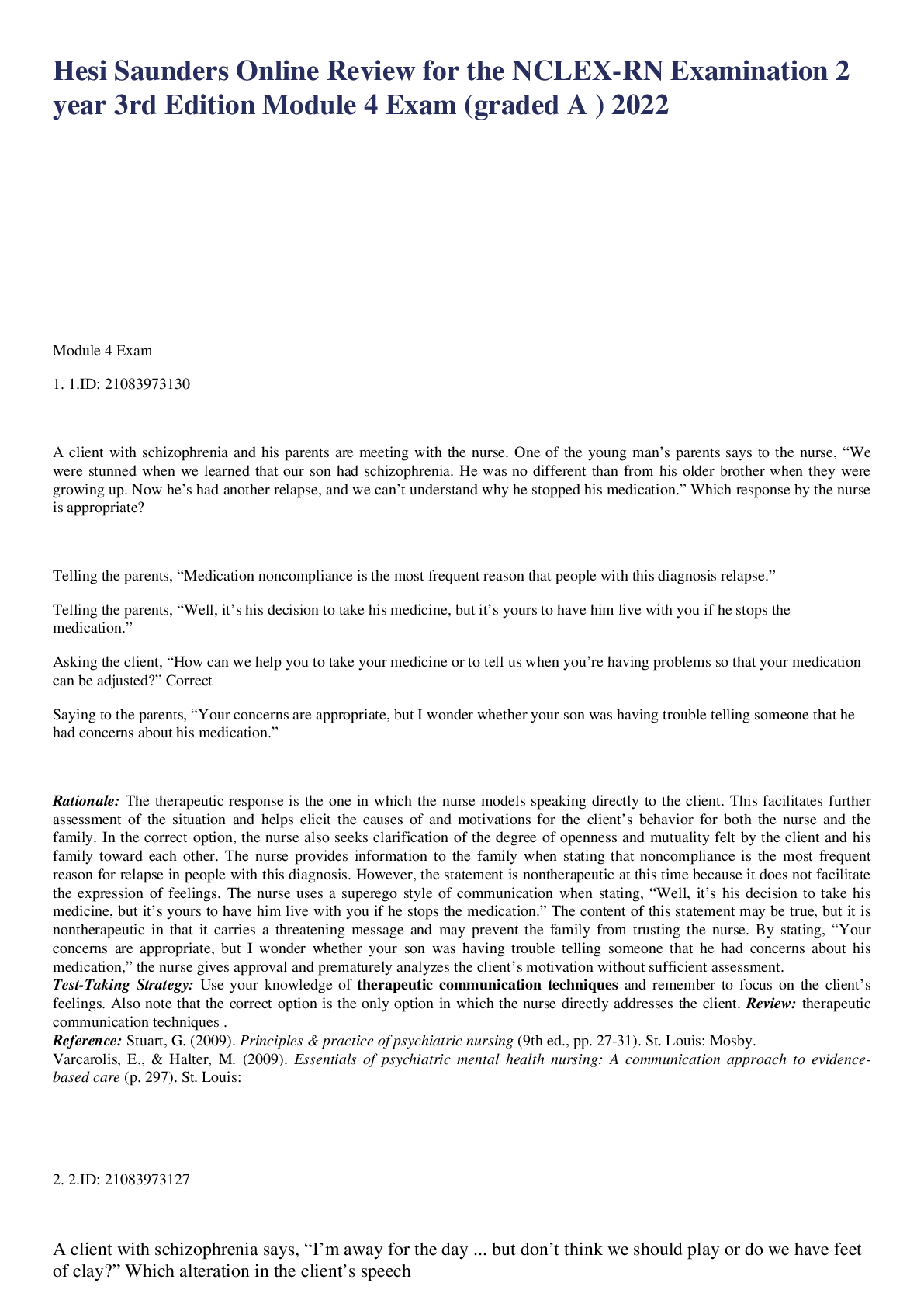
Reviews( 0 )
Document information
Connected school, study & course
About the document
Uploaded On
Oct 10, 2022
Number of pages
66
Written in
Additional information
This document has been written for:
Uploaded
Oct 10, 2022
Downloads
0
Views
72





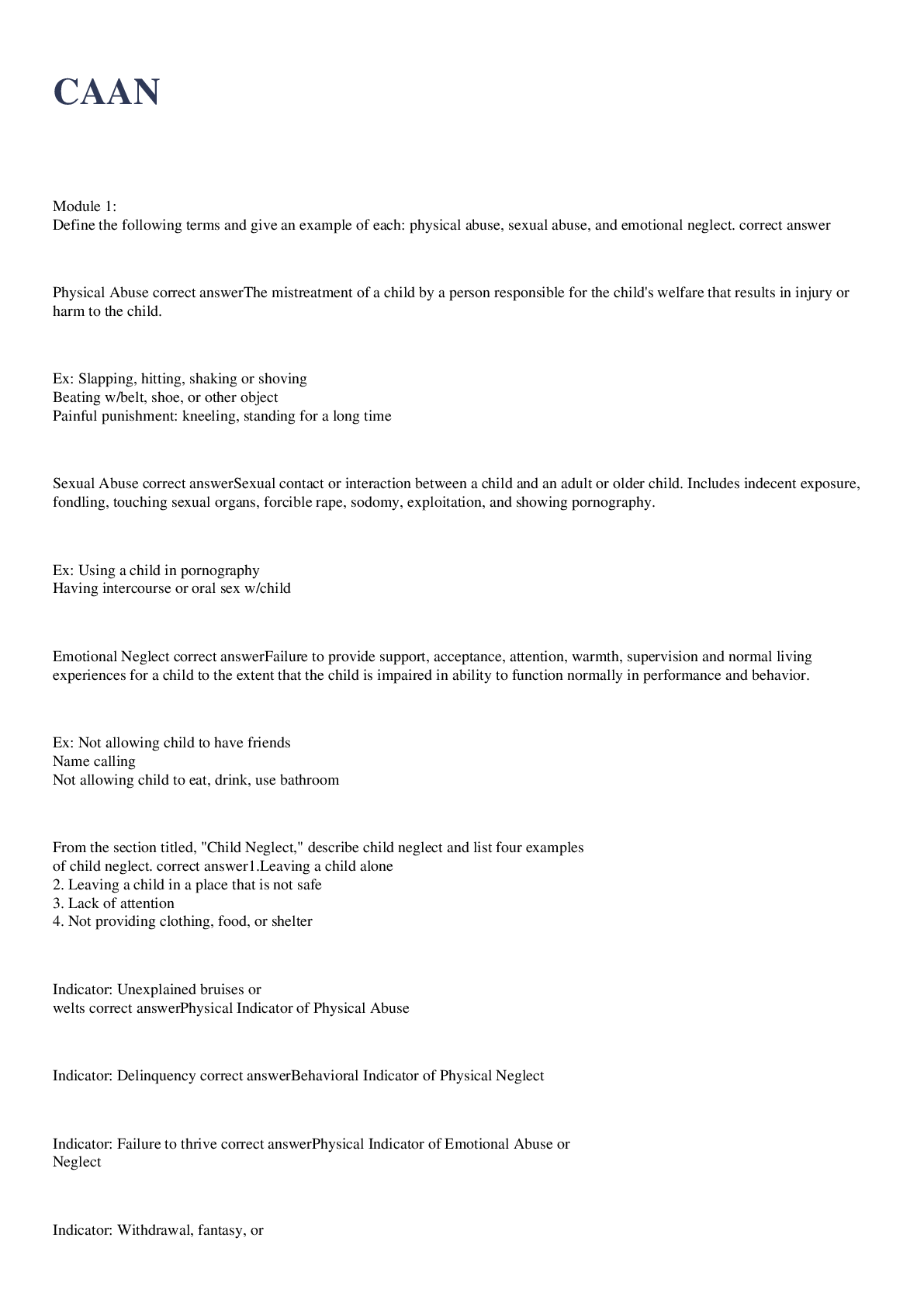
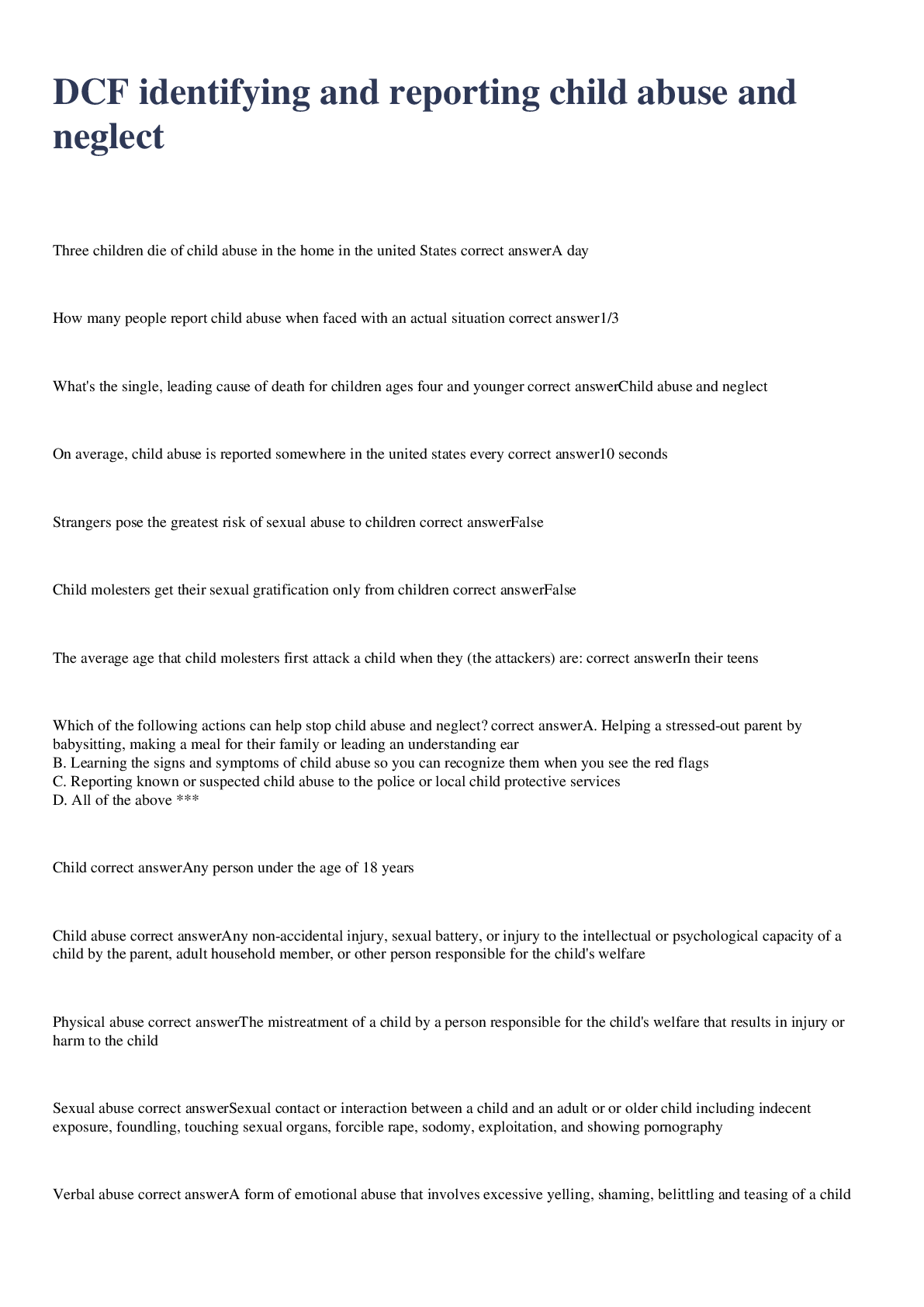

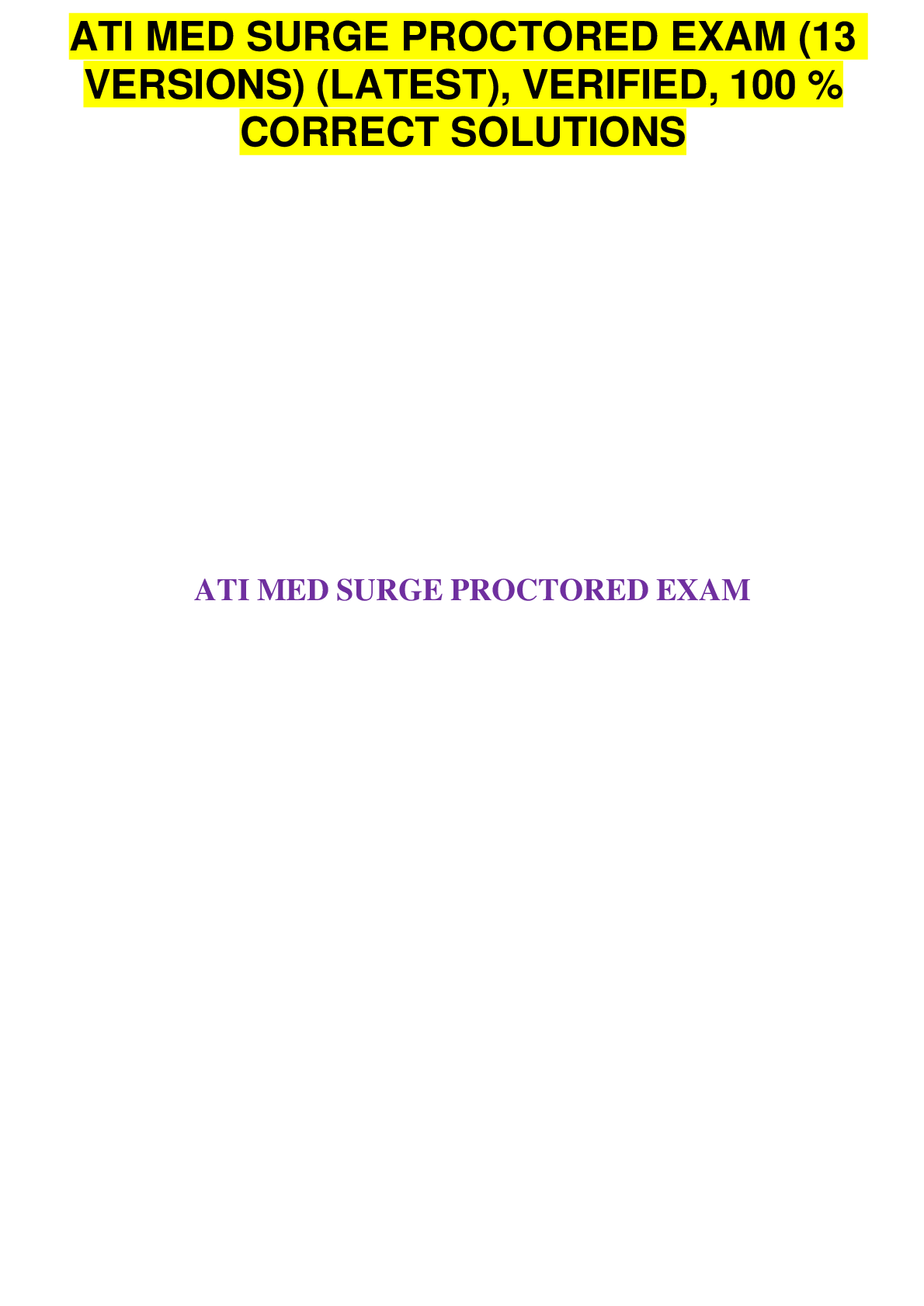



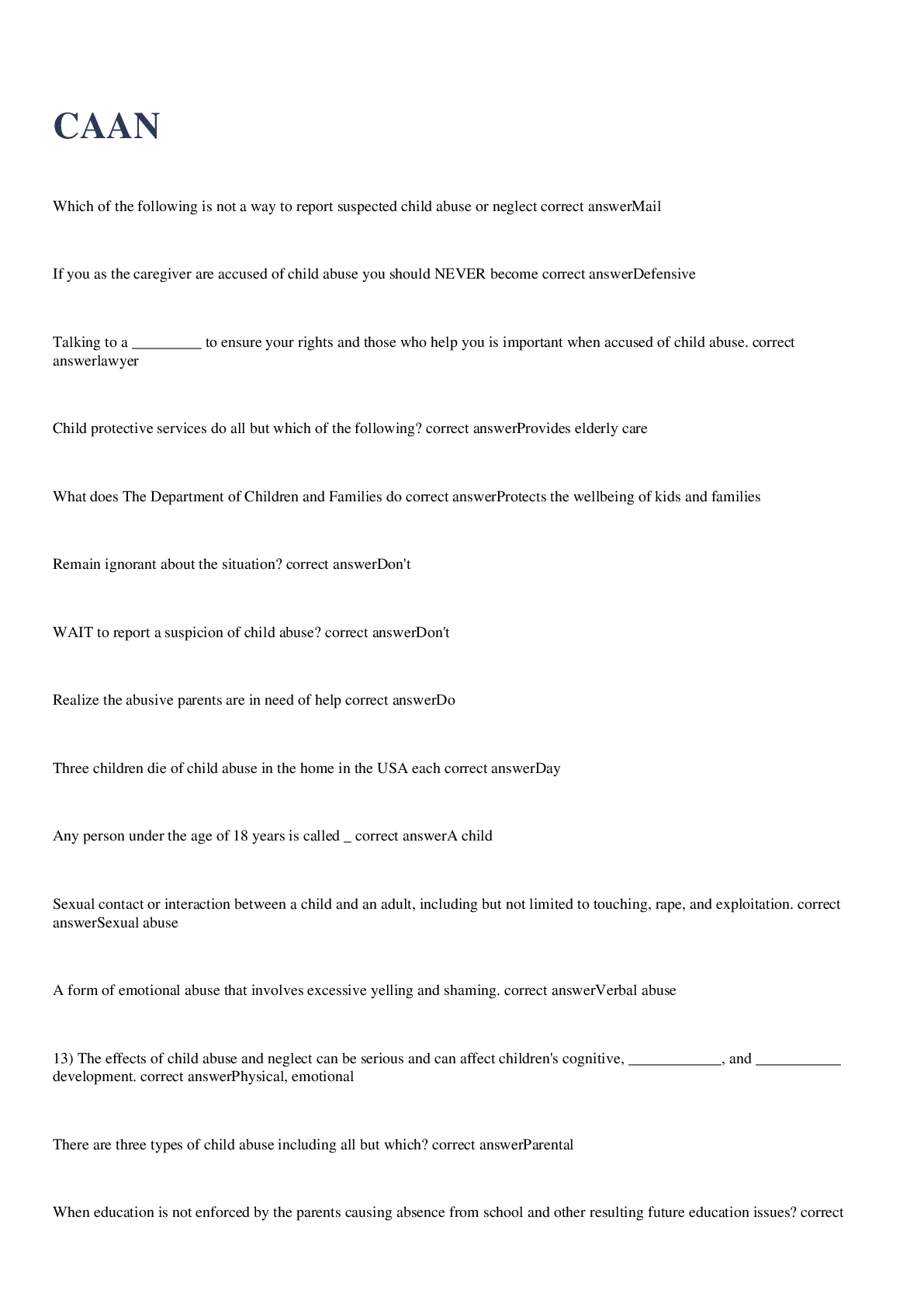


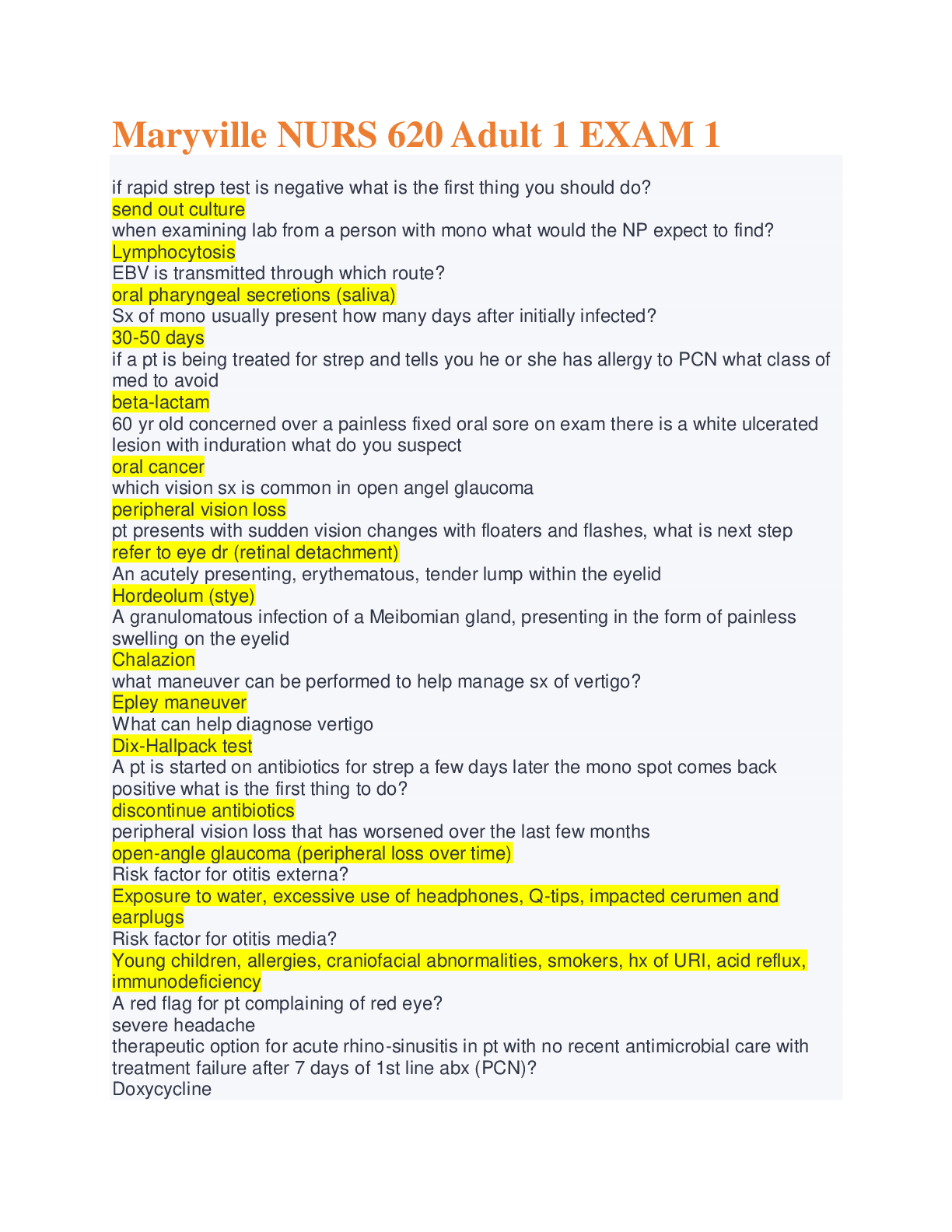

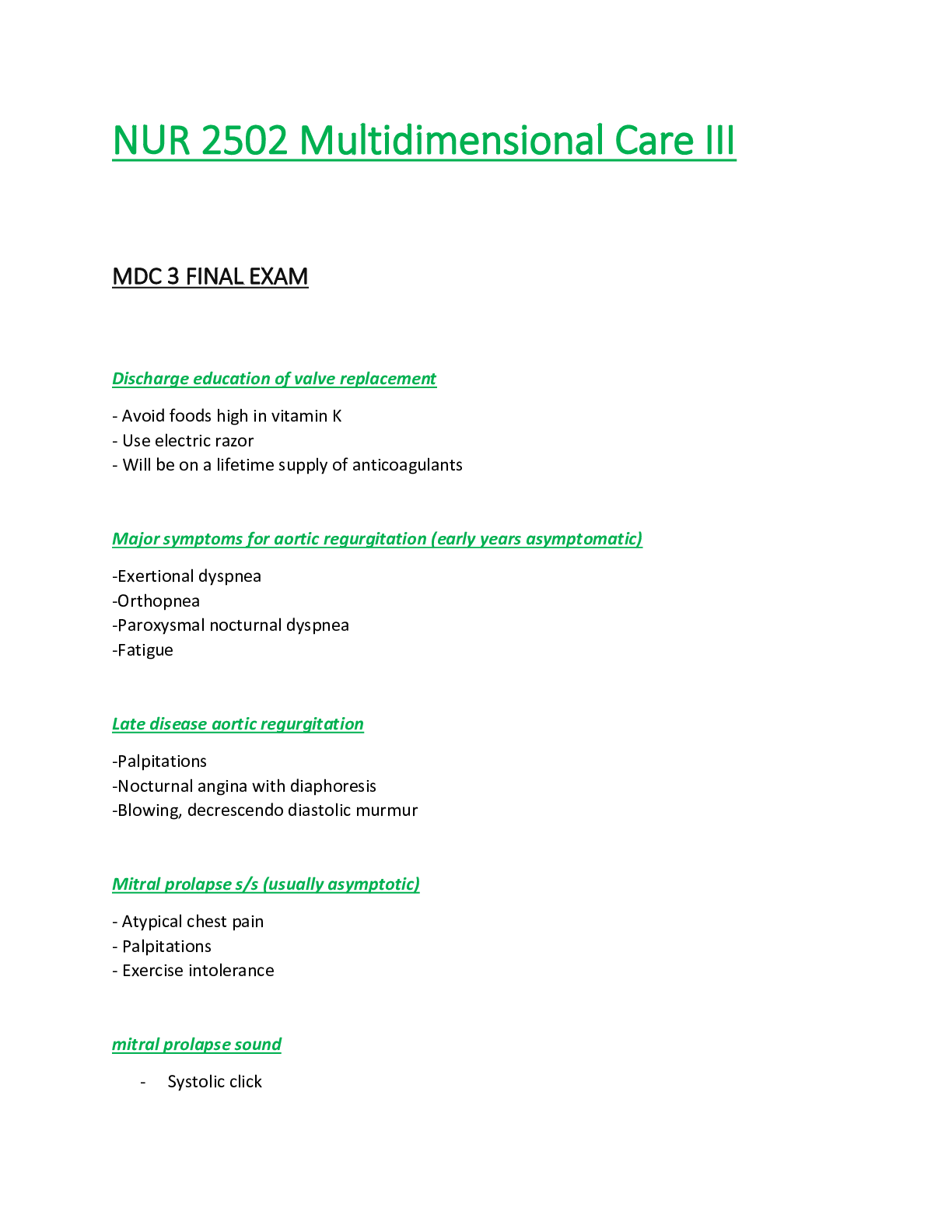


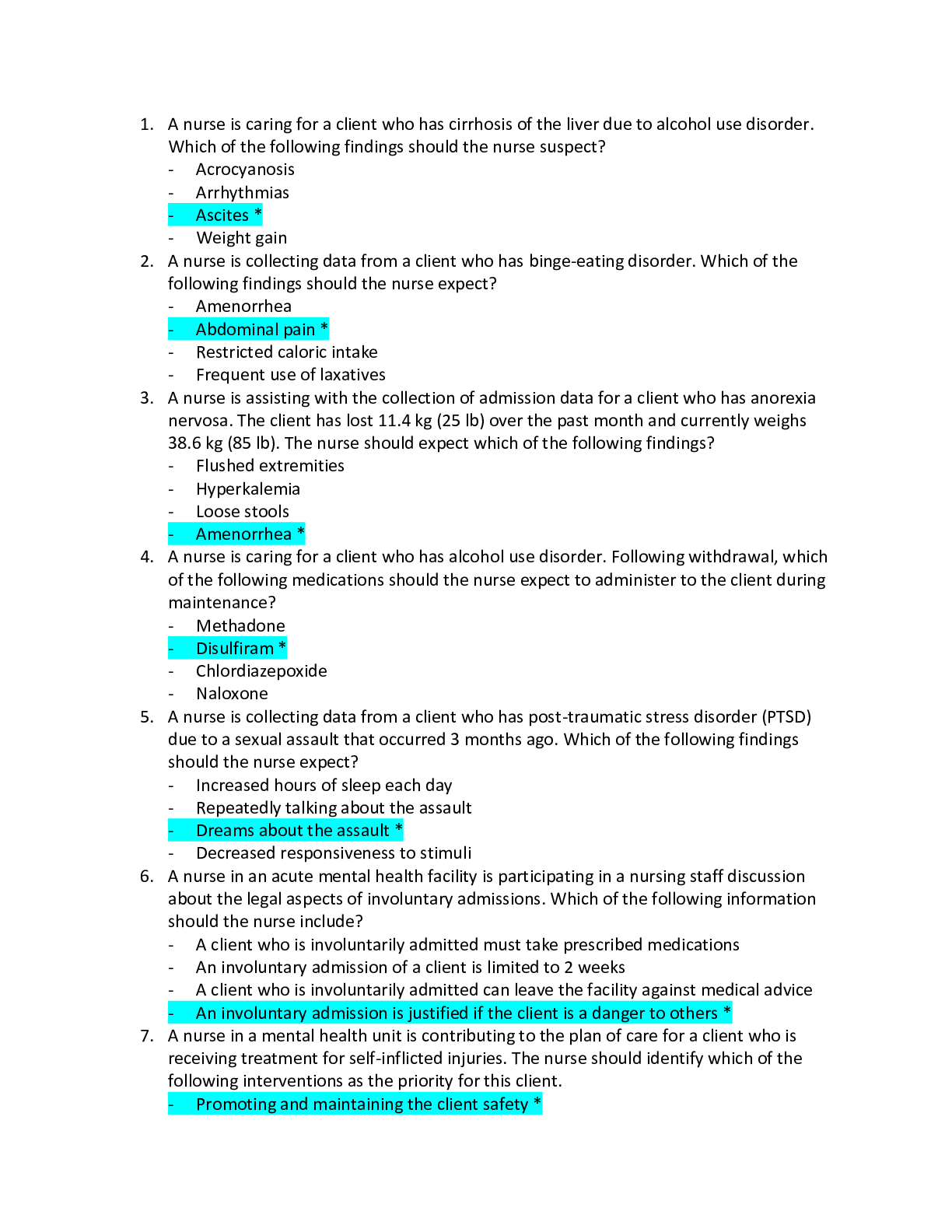

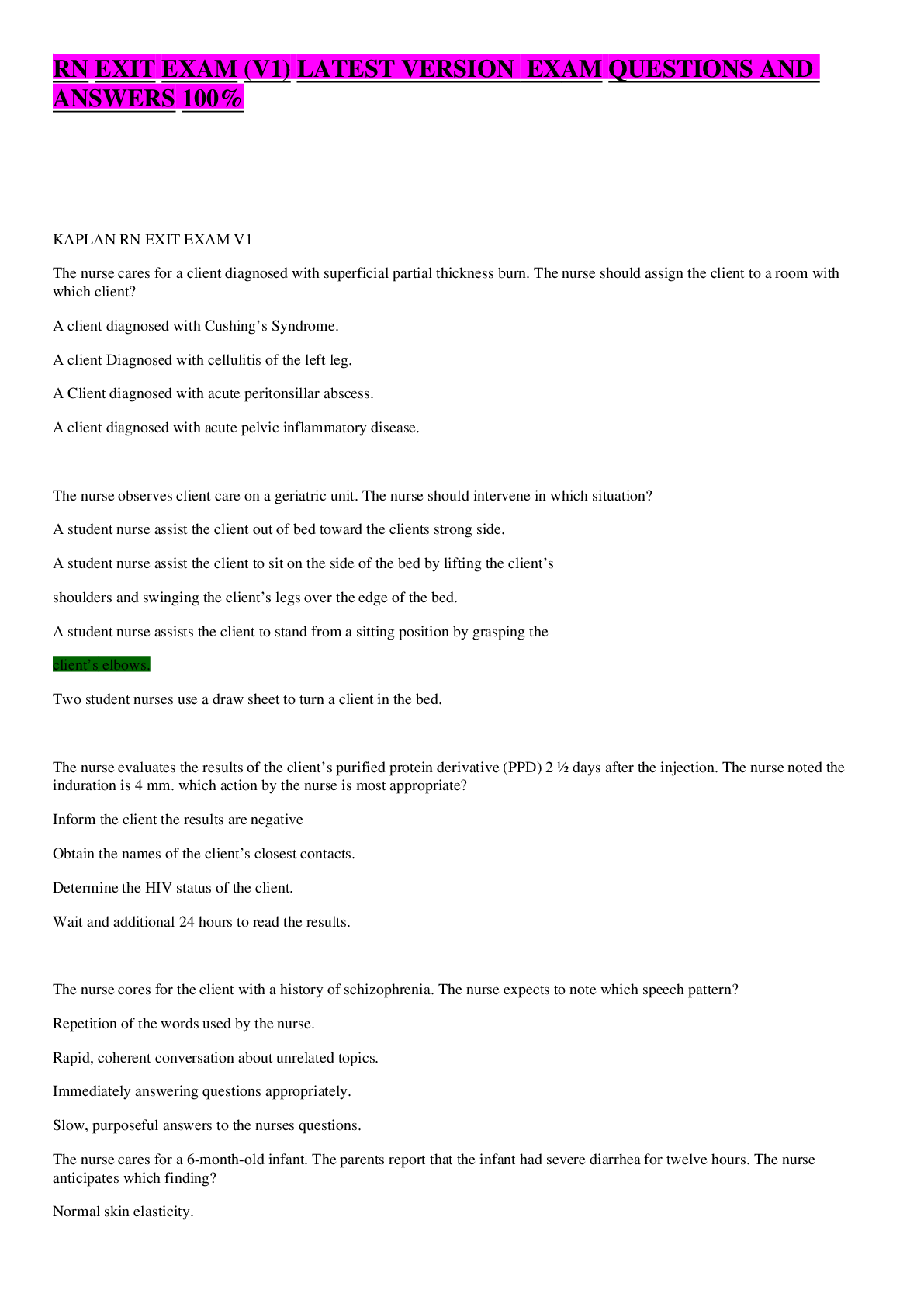

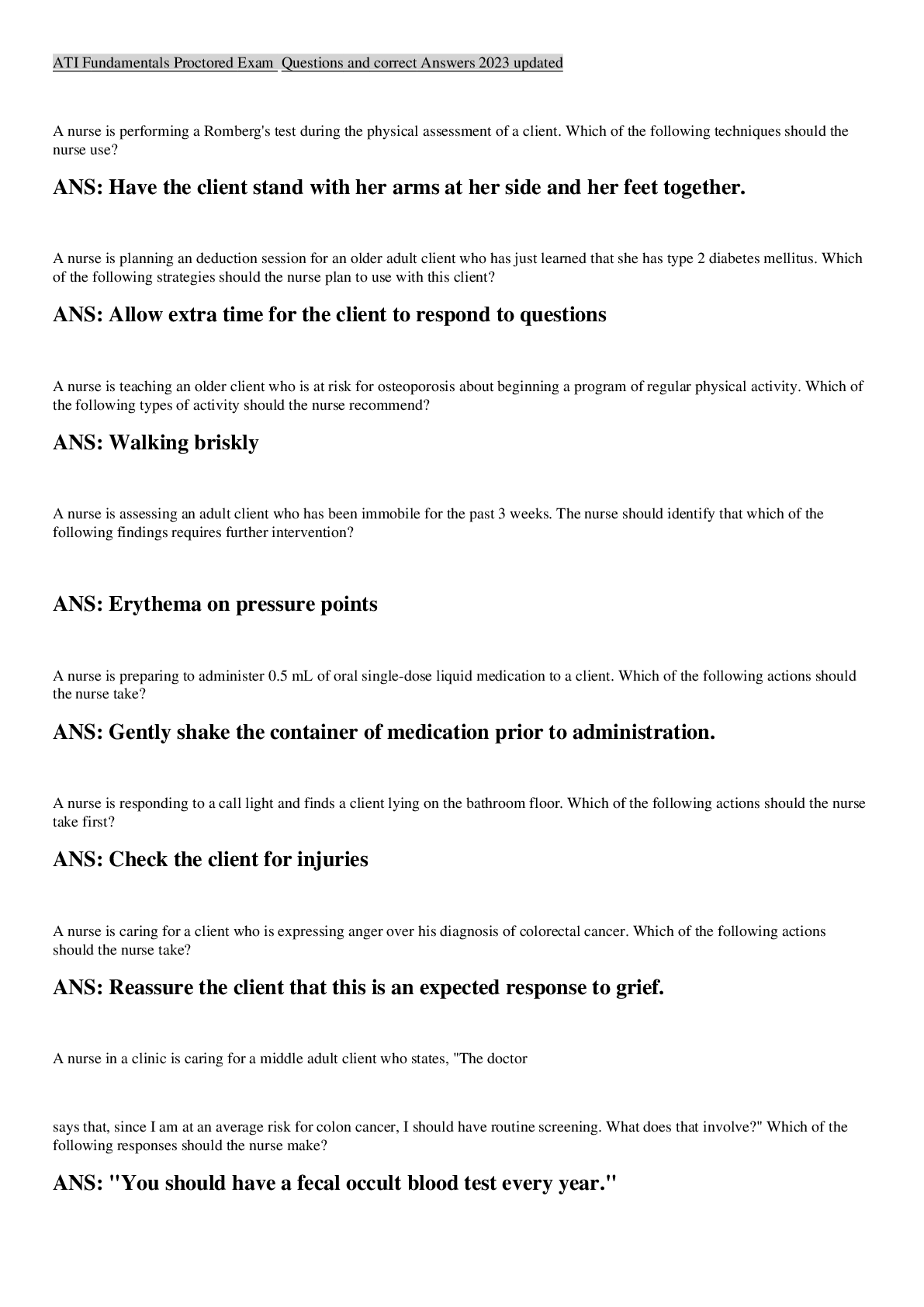
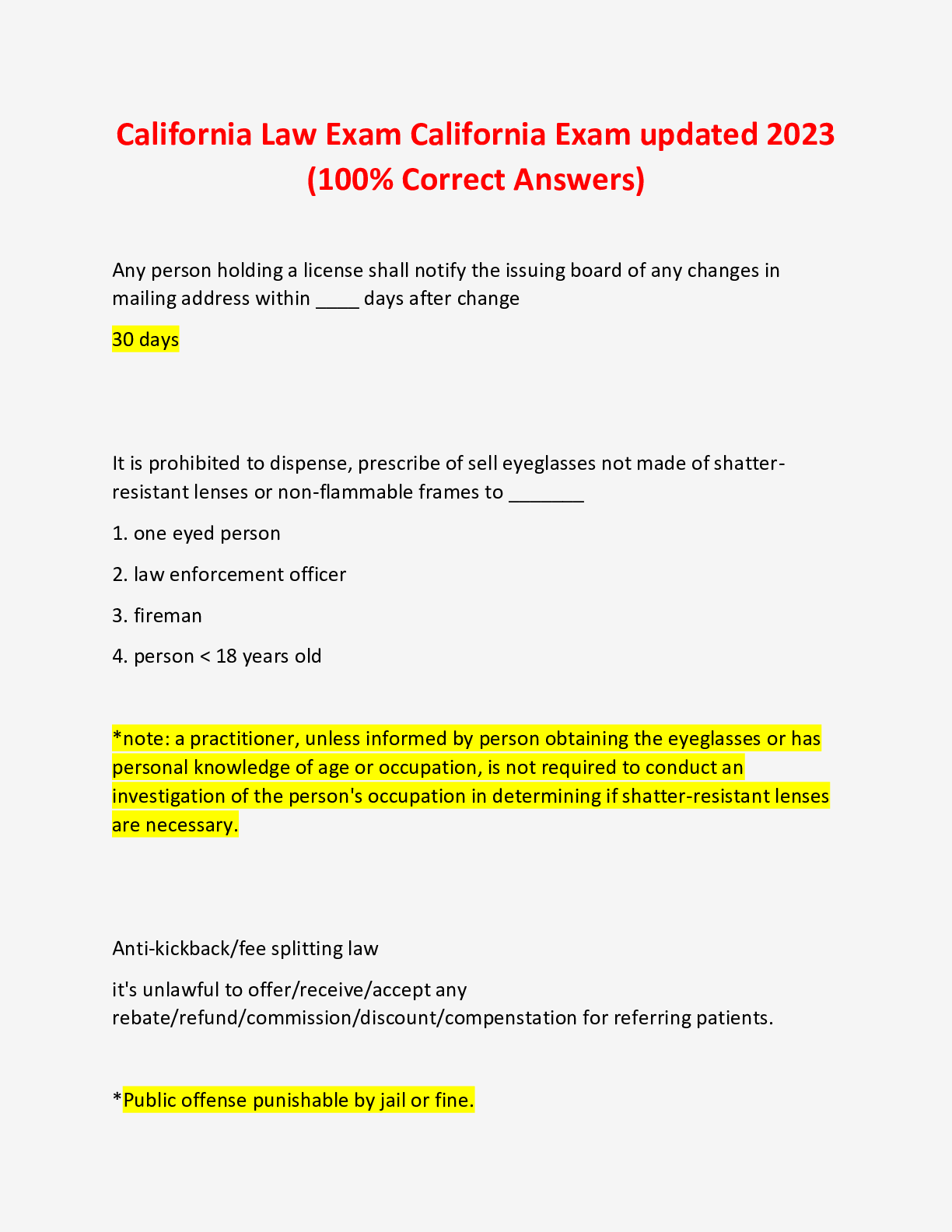
 – Chamberlain College of Nursing.png)



